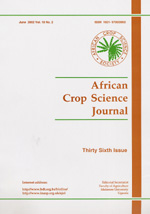
|
African Crop Science Journal
African Crop Science Society
ISSN: 1021-9730
EISSN: 1021-9730
Vol. 6, No. 2, 1998, pp. 159-169
|
 Bioline Code: cs98018
Bioline Code: cs98018
Full paper language: English
Document type: Research Article
Document available free of charge
|
|
|
African Crop Science Journal, Vol. 6, No. 2, 1998, pp. 159-169
| fr |
Amijii, F. & Giller, K.E.
Résumé
Une étude des champs sélectionnés dans les
régions
à haricot de la Tanzanie et une enquéte plus
détaillée des champs
de haricots dans la région de Lushoto, dans le nord de ce
méme pays,
étaient réaliseés en vue d'établir les
propriétés du
sol qui limitent la nodulation racinaire de Phaseolus vulgaris L.
Les échantillons
de sol étaient prélevés et le pH, la matière
organique, la
capacité d'échange cationique ainsi que les concentrations de
P, K, Ca et Mg
échangeables étaient determinés. La vigueur des
plantes et la nodulation
étaient enregistrées et les populations indigènes de
rhizobium favorisant la
nodulation de Phaseolus étaient estimées. La
majorité des sols
avaient une basse concentration de P assimilable mais qui toutefois
correlait bien avec une pauvre
nodulation ainsi qu'avec une pauvre vigueur des plantes. Dans la plupart
des cas, il y avait des
populations suffisantes de rhizobium du sol (102-104 cellules/g sol) mais
les plantes
étaient bien nodulées seulement quand les concentrations de P
étaient
adéquates. Une série d'essais comprenant des traitements
inoculés au
Rhizobium a failli aboutir aux réponses significatives
à l'inoculation,
exception faite à la combinaison des données provenant des 10
sites. Les
résultats confirmaient le besoin de poursuivre les essais en champs
où les
concentrations des élements nutritifs du sols (spécialement
P) sont
généralement inférieures à celles
trouvées dans les stations
de recherche.
Mots Clés
La fixation de N2, phosphore, potassium, nodulation racinaire, pH du sol
|
| |
| en |
Environmental constraints to nodulation and nitrogen fixation of Phaseolus vulgaris l. in Tanzania. I. A survey of soil fertility, root nodulation and multi-locational responses to Rhizobium inoculation
Amijii, F. & Giller, K.E.
Abstract
A survey of selected fields in bean growing regions of Tanzania and a more
detailed survey of
bean fields in the Lushoto area of northern Tanzania were carried out to
establish soil properties
limiting the extent of root nodulation of Phaseolus vulgaris L. Soil
samples were collected
and soil pH, organic matter content, cation exchange capacity and
concentrations of extractable P,
K, Ca and Mg determined. Plant vigour and nodulation were recorded and
indigenous populations
of rhizobia nodulating Phaseolus were estimated. The majority of
soils were found to have
very small concentrations of extractable P and this was associated with
poor nodulation and poor
plant vigour. In most cases there were reasonable populations of soil
rhizobia present (102-104
cells/g soil) but plants were well nodulated only when soil P
concentrations were adequate. A
series of trials which included treatments where rhizobial inoculants were
applied demonstrated no
significant responses to inoculation unless the data were combined across
the 10 sites. The data
confirmed the need for experiments on-farm where soil nutrient
concentrations (especially P) were
generally much less than those found on research stations.
Keywords
N2-fixation, phosphorus, potassium, root nodulation, soil pH
|
| |
© Copyright 1998 - African Crop Science Society
|
|
